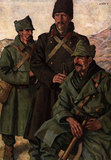-
Story The Romanians
Between the fronts: the restricted development potential of Romanians in the shadow of major power politics
The irredentist tendencies of the Romanians in the Dual Monarchy ran parallel to the emancipation of Romania from Ottoman rule. The chequered relations between Romania and Austria-Hungary offer a textbook example of the connections between domestic and foreign policy in dealing with the complex ethnic situation in south-eastern Europe.
The historical regions of Wallachia and Moldova were united in 1861 for the first time as a modern state in the form of the Principality of Romania. This Romanian nation state, which remained initially under the formal rule of the Sultan, became fully independent following the Congress of Berlin in 1878 and attempted – as a kingdom from 1881 – to participate in the division of the European part of the Ottoman Empire.
Romania was confronted by an overwhelming opponent in the form or Russia, which sought to control the Black Sea region and to establish itself as protector of the Balkan Slavs. The young Romanian state found allies in France (particularly at the cultural level) and Austria-Hungary. In the eyes of Bucharest, Vienna was the ‘natural’ strategic partner in checking what was seen as a pan-Slavic expansionist threat by neighbouring Russia, Serbia and Bulgaria.
In the alliance formed in 1883 by Emperor Franz Joseph and King Carol I of Romania, Bucharest was the junior partner and was therefore able to protect the Romanian minority in Hungary only to a very limited extent.
The First World War was a particular test for the relations between the two states. Romania remained neutral initially as an expression of its disgruntlement with the repressive attitude of Budapest towards the Hungarian Romanians. In 1916 it joined the Entente and launched an offensive against Transylvania. The fighting soon shifted to the Romanian heartland, and Romania was occupied in a concerted action by the Central Powers and was thus put out of action temporarily as the driving force behind Romanian unification.
The momentum did not develop again until right after the war. With the dissolution of the Habsburg Monarchy, the Romanians, hitherto passive, now also wanted to move towards an independent future as a nation. In October 1918 the Central Romanian National Council with representatives from both Transleithania and Cisleithania convened in Budapest with a view to unification with Romania.
Romanian troops occupied Bukovina in mid-November 1918, and on 1 December 1918 the popular assembly in Karlsburg [Alba Julia] announced the union of the Transylvanian Romanians with their compatriots in Romania, after a last desperate offer by the Hungarian government for a federal union with Hungary had been rejected.
On 11 December 1918, the Romanian government in Bucharest under King Ferdinand recognized this decision, effectively a fait accompli confirmed under international law by the Treaty of Trianon in 1920. In spite of the presence of numerous ethnic minorities – Magyars, Germans and Ukrainians – Transylvania, Bukovina and the eastern part of the Banat became part of Romania.
Translation: Nick Somers
Hitchins, Keith: Die Rumänen, in: Wandruszka, Adam/Urbanitsch, Peter (Hrsg.): Die Habsburgermonarchie 1848–1918, Band III: Die Völker des Reiches, Wien 1980, Teilband 1, 585–625
Hoensch, Jörg K.: Geschichte Ungarns 1867–1983, Stuttgart 1984
Hösch, Edgar: Geschichte der Balkanländer. Von der Frühzeit bis zur Gegenwart, München 1999
Kahl, Thede: Rumänien. Band 1: Raum und Bevölkerung. Geschichte und Geschichtsbilder (= Österreichische Osthefte 48), Wien 2008






